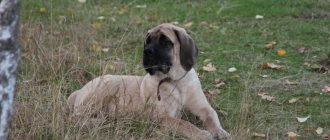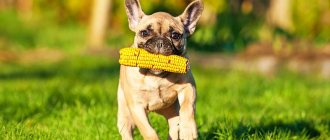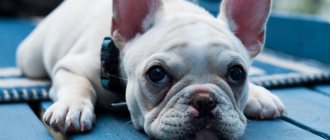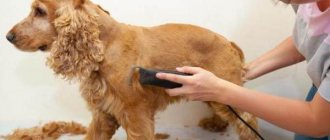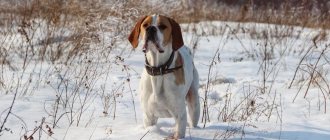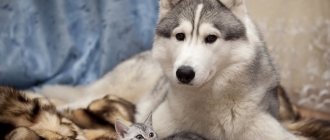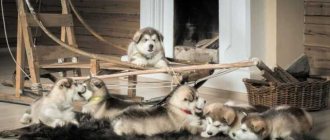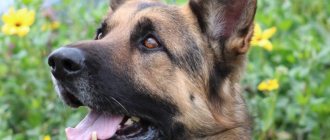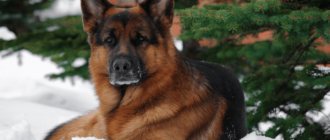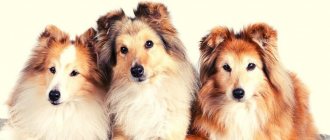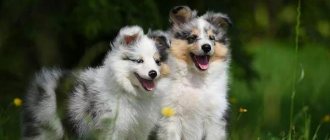What is the color and color of English Bulldog dogs? Breeders have studied how color and patterns are created on the body of an animal. The visible pigment of the outer part of the hair. A significant number of dogs, along with pigmented hair, have white spots or marks in certain areas of the body that are devoid of pigment, i.e. hair lacking pigment. When mixing colors, the color of the dog is determined by the dominant color. A dog has such types of hair as downy, integumentary (smooth), guard hair. The different properties of wool are determined as an adaptation to different climatic conditions and their habitat.
Story
Now it’s hard to believe, but modern calm and phlegmatic bulldogs trace the origin of their breed to the Old English bulldogs - formidable fighting dogs specially bred for baiting bulls (as evidenced by the name of the breed - literally translated “bull dog”). The first mention of bulldogs as a separate breed dates back to the 17th century.
These dogs were specially bred for fighting, which determined their appearance and character: stocky, wide chest, short hair, small ears, powerful jaws - as well as high aggressiveness, unquestioning devotion to the owner and immunity to pain.
Bull baiting was banned in Great Britain in 1835, which led to a decline in the popularity of bulldogs. Outside of combat, this breed was simply useless. The demand for dogs fell, and by the middle of the century, bulldogs were on the verge of extinction. However, among the breeders there were connoisseurs of the breed who decided to restore it.
Through considerable efforts of breeders, the least aggressive dogs were selected, which became the ancestors of the updated breed. The English Bulldog was officially recognized by the English Kennel Club in 1873 and within a few years gained popularity not only in its homeland, but throughout Europe. This is such an interesting history of this breed!
The English Bulldog belongs to the Molosser dog , a group that includes herding and guard breeds. And although today he is considered a companion dog, he still has many typical “Molossian” features of body structure, physiology and character.
Patient, but...
They are usually not aggressive towards strangers. They get along easily with other pets. There is an alarming feature - a dog can tolerate it for a very long time, but if you anger it, it will be very difficult to stop.
Note!
Nicknames for dogs for boys - easy, rare and most beautiful names for dogs in alphabetical order
Nicknames for girls' dogs - a list of beautiful, funny, unusual nicknames for large and small dog breeds
Maltipoo dog - everything about the dog from A to Z. Photos, description of the breed, character, maintenance features, prices, reviews
Description
Let's study a detailed description of the dog breed.
Appearance standard
- The English Bulldog is a short-haired dog with medium-coarse hair that fits tightly to the body.
- color two-color (red and white) is most common brindle, solid (white, red, fawn, reddish-yellow) or smut (solid color with a black muzzle) are also possible. Black, black and tan, and liver colors are considered faulty.
- The Bulldog is a stocky, dense dog with a large, wide head, a thick, powerful neck, a short back, noticeably arched towards the waist, a tucked belly and low, muscular limbs.
- The tail is short, low set, thick at the base.
- muzzle , with a massive square lower jaw noticeably protruding forward.
- The cheeks are protruding, the jowls are thick and dense, covering the jaw on both sides.
- The eyes are widely spaced, medium in size, dark brown in color.
- The ears are small, thin, set high, widely spaced, directed down and back, forward or semi-erect (rose, bud and tulip shapes). The show standard allows only rose-shaped ears ; other shapes are considered faulty.
Bicolor
brindle
Smoot
Our entire editorial team fell in love with this handsome black guy!
Dimensions
The height of a bulldog at the withers can vary from 31 to 40 cm - this parameter is not fixed in canine standards.
How much does it weigh? The average weight of an adult male dog is 23-25 kg, females – 22-23 kg.
As bulldog puppies grow, they gain weight very quickly. The weight dynamics by month is as follows.
Weight table
How much should a bulldog weigh:
- newborn puppies weigh only 300-400 grams. However, their daily weight gain is very significant, and by the end of the first month of life the puppy already weighs about 1.5 kg;
- by the 2nd month, the puppy’s weight almost quadruples – it is just over 4 kg;
- at 3 months, with proper care, the puppy already weighs 8 kg;
- by 4 months the puppy’s weight is 10-11 kg;
- by 5-6 months the puppy turns into a teenager, its body acquires “adult” proportions, and its weight reaches 15-17 kg;
- at 7-9 months, a young bulldog already weighs 19-20 kg;
- in the period from 9 months to a year, the bulldog no longer actively gains weight; The average weight of a one-year-old dog is 21-22 kg.
Barking
An interesting feature of the breed is that English bulldogs practically do not bark. The voice of this dog can be heard very rarely - phlegmatic bulldogs extremely rarely bark even when an unfamiliar person or animal appears. They can be safely left alone for a while - unlike many breeds, bulldogs will not howl and whine while waiting for their owner.
How many years have they lived at home?
The average life expectancy of these dogs, unfortunately, is short - 8-10 years, which is typical for most Molosser dogs. The fact that the bulldog is a very sickly breed, which is characterized by many diseases, both congenital and acquired, also plays a role. But with quality care and timely vaccination, bulldogs live much longer - from 12 to 16 years.
It is important to remember that the quality and life expectancy of a bulldog very much depend on the owner and the efforts he makes.
Appearance of an English Bulldog
English bulldogs have a massive head and a small pelvis. Due to these structural features that do not allow puppies to pass through the birth canal normally, representatives of this breed often give birth with the help of a veterinarian who performs a cesarean section. In addition, the English Bulldog is a brachycephalic dog, the distinctive feature of which is a depressed nose and head.
These funny "Englishmen" are also distinguished by ungentlemanly behavior. Since they breathe with an open mouth, they swallow a lot of air, which, in fact, causes flatulence. Owners need to either just get used to it or keep an air freshener with them at all times.
general description
The English Bulldog is a medium-sized dog. He is smooth-haired, tightly knit and squat. The head is distinctly large, massive, its girth is equal to the height of the dog at the withers. A characteristic feature of bulldogs is a short and wide muzzle with an equally wide and large nose.
Height at the withers depends on gender. For males it is 36-41 cm, for females – 30-36 cm. Males have more weight, it is 20-25 kg. Bitches weigh 16-20 kg.
The English Bulldog combines not only the functions of a watchman, but also a bodyguard, a cheerful companion and a reliable friend. The dog's character is quite affectionate, but thanks to its menacing appearance, it can replace a guard dog: the bulldog scares away unexpected guests who covet other people's property.
Head
The head, when compared with the size of the dog as a whole, is quite large. But at the same time, it does not violate the overall symmetry, so the English bulldog does not look deformed, otherwise the quality of its movements would suffer. The muzzle is wide and blunt, and is distinguished by an upward curve.
The bulldog's forehead is flat, not too protruding or drooping above the muzzle. There are pronounced folds on the forehead and skin around the head. A groove is visible from the stop to the top of the skull - it is distinctly wide and deep.
The frontal bones are convex and prominent in projection. They are also distinguished by their height, width and square shape.
Teeth
The English Bulldog boasts a wide and massive square-shaped jaw system. The lower jaw, unlike the upper, protrudes forward and is curved upward. The jaw has six incisors located between the fangs in a straight line. The latter have a wide arrangement.
Representatives of the breed have large and powerful teeth, which, if the mouth is closed, are completely hidden in the mouth. When viewed from the front, you can see that the lower jaw is parallel to the upper jaw - it is located directly below it.
Eyes
Serious bulldog
The location of the eyes on the skull is low, at a decent distance from the ears. They are in line with the stop and are located at right angles to the furrow.
The eye placement is wide, but the outer corners are located inside the outer line of the cheeks. Their shape is round and their size is medium. They do not sink into the eye socket, but they are not convex either. The eye color is very dark, almost black. When viewed from the front, they do not detect any visible proteins.
Ears
The English Bulldog's ears are set high. When viewed from the front, each ear's front edge touches the upper corner of the skull, namely its outer line. Thus, the ears are placed as high as possible and far from the eyes.
The shape of the ears is the so-called rose: they hang and face back, that is, towards the back. The anterior or superior edge is characterized by a curvature both backward and outward. Thanks to this, the so-called back of the tongue is partially visible.
Nose and lips
These are the lips!
The nose of the English Bulldog is wide and large, it is deeply recessed between the eyes. The nasal fold does not affect the profile line. The color is black, there are no inclusions of brown, liver or red. The nostrils have similar characteristics. In addition, they are open, and a vertical groove is clearly visible between them.
The lips are wide and thick and at the same time very deep and drooping. Thanks to the latter quality, they completely close the jaw from the sides. But this does not happen in front: here the lips only cover the teeth.
Neck
The English Bulldog has a neck of medium length, strong, robust and very thick. It has a slightly convex shape. There is thick, loose and folded skin around the throat, forming a double chin (dewlap) that extends from the lower jaw to the chest.
The breed standard requires that the length of the neck be in harmony with the size of the dog's head and body. If the neck is short, this may indicate that the animal has respiratory problems, not to mention the fact that insufficient length does not have the best effect on the general appearance of the English Bulldog.
English bulldog muzzle
Frame
The topline, when viewed just behind the withers, is slightly lowered at the very bottom. Then it rises to the lower back, becoming a level higher than the height of the dog at the withers, and, rounding, decreases towards the tail. Thanks to such “intricacies” of the topline, a sail arch is formed, which is one of the calling cards of the breed.
Our “gentleman’s” back is short and distinguished by his power. The English Bulldog is broad in the shoulders. Relatively narrow back only in the lower back.
The chest of representatives of this breed is wide and deep, from the withers and directly to the very bottom, and also convex and rounded on the sides.
The dog's belly is toned and does not sag.
Tail
You take a walk yourself, and I’d rather sit here
The tail is set low, quite straight and thick at the base, and then curves down and tapers towards the end. The shape is round, the skin on the tail is smooth, there is no coarse hair, and there is no fringe. If we talk about the length, it is rather short. It never rises above the back.
Limbs
The English Bulldog has large, strong and robust forelimbs. They are thick, with well-developed muscles, and have a wide stance.
The outer line of the limbs looks noticeably curved, but their bones are straight: no curvature or bending is observed in them. They are short in comparison to the hind legs, but not so short that they make the dog's back appear longer than they actually are, or that they interfere with your pet's daily activities.
The shoulders are wide, they are distinguished by power, they have developed muscles. But they can also be described as deep, sloping and sloping. The elbows are low and spaced from the ribs. The pasterns can be described very succinctly: powerful, straight and short.
The hind limbs of bulldogs are also large and muscular. Since they are longer than the front ones, this results in the effect of raising the dog’s lower back. The lower part of the hind legs has the following characteristics: it is straight, short and powerful. Round knees are characterized by a slight turn away from the dog's body. The hock joints are low and slightly curved, with moderate angulation.
Both the front and hind legs have the outward turn characteristic of the breed. The only difference between them is that the first are medium in size, straight and moderately rounded, while the second are compact, round in shape. The toes of the hind legs are arched and thick, as a result of which their joints are raised and, accordingly, protrude high.
The English Bulldog is distinguished by a peculiar, one might even say, gait that is not quite usual for dogs. He moves with short, quick strides on his fingertips. At the same time, the hind legs do not rise high, so our “gentleman” shuffles slightly. The breed standard suggests that quality and confidence of movement are of great importance.
Wool
Short, with a delicate texture. It is smooth and fits tightly. Shouldn't be wavy.
Color
It is distinguished by uniformity, purity and brightness. There are different colors in the English Bulldog breed, but preference should be given to red brindle and all other brindle colors, white, red, fawn, piebald - and in that order.
English bulldog white color
If you choose from a good piebald, a dirty piebald or a dirty solid, then a good piebald is preferable.
Black color is considered vicious and is allowed only in piebald color in the form of spots in moderate quantities. To prevent a spotted color from being perceived as defective, the colors should be evenly distributed in small spots.
If your pet has a small white spot on his chest, this is acceptable, but only in two color options: solid and brindle.
Possible defects
Any deviation from the listed standards of head, teeth, eyes, ears, neck, body and limbs should be considered as faults or faults of the breed.
The degree and depth of these deviations are judged depending on their impact on the health and daily functioning of the dog.
Disqualifying faults
If an English Bulldog shows aggressiveness or excessive timidity, if it has noticeable respiratory distress or an ingrown tail, then such defects are considered disqualifying.
Any dog exhibiting abnormal behavior or mental abnormalities must be disqualified.
Please note: male dogs must have two normally developed testes, fully descended into the scrotum.
Pros and cons of the breed
Peculiarities
The modern English bulldog is a completely artificial breed with its own unique characteristics. And, like most creations of breeders, it is characterized by many specific diseases.
The most common types of diseases in this breed are:
- diseases of the cardiovascular system (including congenital);
- respiratory tract diseases;
- eye diseases;
- obesity;
- skin diseases;
- allergies;
- oncological diseases.
During the selection process, breeders sought to achieve a certain body structure of the dog - squat and “square”. As a result, in a modern bulldog the main load from body weight falls not on the bones of the legs, but on the muscles. Due to this, bulldogs quickly gain muscle mass, however, such a redistribution of the load requires increased energy expenditure - dogs quickly get tired, suffer from shortness of breath and often have problems with the cardiovascular system. Thus, representatives of this breed often have mitral valve stenosis and stenosis of the pulmonary artery.
Watches your figure!
To restore strength, a bulldog requires many hours of rest and high-calorie food . If not properly controlled, this regimen can lead to an obese dog. The already considerable load on the heart increases even more, the dog ages faster, its life expectancy is reduced, and if the dog had congenital heart diseases, they worsen and begin to progress.
Due to the specific shape of the head – flattened and “square” – many bulldogs develop the so-called brachiocephalic syndrome – shortening and deformation of the airways, leading to breathing problems. The main stages of development of brachiocephalic syndrome are:
- narrowing of the nostrils and nasal passages;
- lengthening and thickening of the soft palate;
- deformation of the larynx.
This condition is a frequent companion of all breeds with short muzzles, not only bulldogs, but also pugs, Pekingese and many others. Brachiocephalic syndrome develops gradually and it is important to catch it early. Timely surgical correction (dilation of the nostrils, resection of an enlarged soft palate) can prevent pathological changes in the larynx.
You can understand that a bulldog is developing brachiocephalic syndrome by the following signs: loud snoring, noisy, hoarse breathing, bubbling in the throat, frequent shortness of breath, even after minor physical exertion. If such signs are detected, the dog should be immediately taken to the veterinarian.
Bulldogs often have diseases and defects of the eyes and eyelids, including congenital ones. These dogs are often diagnosed with diseases such as:
- bilateral cataract;
- “cherry eye” – hypertrophy and prolapse of the gland of the nictitating membrane of the eye;
- eversion or inversion of the eyelid;
- keratitis (“dry eye”) – disruption of the lacrimal gland and decreased production of tear fluid;
- trichiasis - a disorder of eyelash growth in which they are directed towards the eye;
- double eyelashes.
Skin diseases are also found in bulldogs - papillomas and bacterial lesions . They can be easily prevented by caring for your dog, bathing it on time and treating skin folds.
Get well soon, dog
